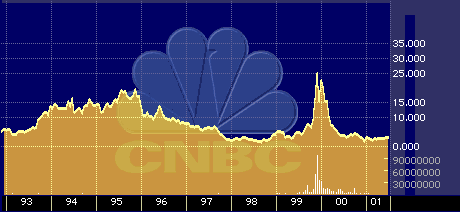
Corel Rides Linux Bandwagon
Corel Rides Linux Bandwagon
by Hal Plotkin
Silicon Valley Correspondent
Corel Corp. {CORL}, the maker of the once-dominant WordPerfect word-processing software, is hitching its wagon to the fast-rising Linux star.
The Canadian company plans to release an easy-to-install version of the Linux operating system, called Corel Linux, early next year. The product drew rave reviews at a recent trade show in San Jose, Calif. Meanwhile, the company’s new Linux version of WordPerfect has rapidly become one of the most popular Linux programs on the market.
“They are pushing Linux to new levels of ease-of-use,” says Greg Weiss, an analyst at D. H. Brown, a technology-research firm in Port Chester, N.Y.
These developments could further increase investor interest in Corel’s stock, which doubled in the past 12 months, after languishing last year.

CORL historic stock-price chart
“It’s definitely a positive move,” says Sandra Potter, research director at the Aberdeen Group, an information-technology consulting and marketing firm based in Boston.
Potter adds that she thinks it will still be “at least a year or two,” before Linux begins to make serious inroads into the desktop market. At present, the Linux operating system is used on only 2.1 percent of the approximately 89 million “client” PCs, according to International Data Corp., based in Framingham, Mass.
Corel’s new WordPerfect software runs on various versions of the Linux operating system that is now available from a number of different sources. Corel’s pending release of its own version of the Linux operating system is aimed at making it easier for consumers to use a variety of Linux applications, including the new version of WordPerfect.
“I’m sure a lot of users are going to be happy to see WordPerfect return,” Potter says. “It’s the word processor a lot of people grew up with.”
Five years ago, WordPerfect was the dominant word processor, controlling 31 percent of the market. Since then, however, Corel’s product has skidded into third place, currently owning just 9 percent unit market share, according to PC Data Inc., a market-research firm based in Reston, Va. Microsoft’s Word software, by contrast, controlled about 40 percent of the word-processor market as of June.
There are already signs that Corel’s new Linux strategy is getting traction.
WordPerfect for Linux was the single most popular piece of Linux software downloaded from CNet’s Download.com Web site for the week ended Aug. 22. With more than 7,000 downloads in one week, WordPerfect beat out the Linux program distributed by Durham, N.C.-based Red Hat Inc. {RHAT}, whose shares skyrocketed after the company went public on Aug. 11.
According to Corel, more than one million copies of WordPerfect for Linux have already been downloaded from Corel’s own corporate Web site.
Earlier this month, Corel previewed Corel Linux to rave reviews at the Linuxworld Expo and Conference held in San Jose, Calif. The demo drew oohs and ahs from a standing-room-only crowd at the Corel booth.
What captured their attention was Corel Linux’s novel, new installation features that make it easy to install Linux on a new computer or on a computer that already has Microsoft’s Windows operating system installed.
Previously, devotees of the Linux operating system often attended all-day “install-fests” where they would help one another cope with the complexities involved in installing earlier versions of Linux. By contrast, the Corel Linux program installed itself, with a little help from a user drawn at random from the crowd, in about five minutes.
Linux is an open-source computer operating system that competes primarily with Microsoft’s Windows NT. Unlike proprietary software products sold by companies such as Microsoft, the vendors of open-source software products such as Linux make the source code of their products freely available. Source code is the usually-hidden software instructions that programmers need in order to modify or improve software.
Corel’s embrace of Linux recently led both Christopher Galvin, senior analyst at Hambrecht & Quist, based in San Francisco, and Al Tobia, an analyst at Banc of America Securities, also based in San Francisco, to add Corel to their lists for the Mutual Fund Stock-Picking Contest sponsored by Computer Reseller News, a trade publication.
“We expect investor awareness [of Linux] to increase with the Red Hat IPO,” Tobia, a two-time winner of the contest, told CRN. He added that he expects investors will “respond accordingly” by bidding up Corel’s stock.
Weiss adds a note of caution: “Building a new Linux installer is one thing,” he says. “But is it good enough to take out a company like Microsoft? Unseating a monopoly in the area of their core competence is very difficult.”
Early this month, Corel got some unwelcome ink when a Canadian newspaper reported that Corel CEO Michael Cowpland was under investigation for allegedly selling a block of stock in 1997 just before his company posted surprisingly poor financial results. A Corel spokesperson has since downplayed the news, maintaining that Corel hasn’t been contacted by the Ontario Securities Commission.
Last week, Ziff-Davis announced that Cowpland will be a keynote speaker during the September 28 to 30 COMDEX trade show in Miami, a high-profile appearance that will almost certainly garner more attention for Corel’s new suite of Linux products.
Corel posted net profits of $9.1 million for the fiscal second quarter ended May 31, on sales of $70.5 million. That compares with a loss of $8.3 million on revenue of $63 million for the same quarter last year.


